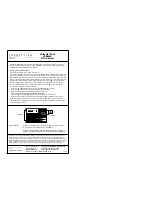
EVA-7M - Hardware Integration Manual
UBX-12003235 - R05
Production Information
Design-in
Page 13 of 42
Figure 3: RTC crystal
2.4.2
RTC derived from the system clock
The EVA-7M can be configured in such way that the reference frequency for the RTC is internally derived from
the 26 MHz crystal oscillator. For this feature
RTC_I
must be connected to ground and
RTC_O
left open. The
capacity of the backup battery at
V_BCKP
must be dimensioned accordingly, taking into account the higher
than normal current consumption at
V_BCKP
in the event of power failure at
VCC_IO
.
The single crystal feature can be configured by sending the following sequence to the receiver:
B5 62 06 41 0C 00 00 00 03 1F 47 F2 D7 AD FF FF FC FF 2B 3D
Applying this sequence results in a permanent change and cannot be reversed.
2.4.3
RTC using an external clock
Some applications can provide a suitable 32.768 kHz external reference to drive the EVA-7M RTC. The external
reference can simply be connected to the
RTC_I
pin. Make sure that the 32.768 kHz reference signal is always
turned on and the voltage at the
RTC_I
pin does not exceed 350 mVpp. The level (typ. 200 mVpp @ RTC_I)
adjusting can be achieved with a resistive voltage divider followed by a DC blocking capacitor in the range of 1
nF to 10 nF. Also make sure the frequency versus temperature behavior of the external clock is within the
recommended crystal specification shown in section B.1.
2.4.4
Time aiding
Time can also be sent by UBX message at every startup of the EVA-7M. This can be done to enable warm starts,
AssistNow Autonomous and AssistNow Offline. This can be done when no RTC is maintained.
To enable hot starts correctly, the time information must be known accurately and thus the TimeMark feature
has to be used.
For more information about time aiding or timemark see the
u-blox 7 Receiver Description including Protocol
Specification
For information of this use case it is mandatory to contact u-blox support team.
For Power Save Mode operations where the RTC is needed, the time aiding cannot be used. This is
because the host does not have any information about when the EVA-7M turns from OFF status to ON
status during ON/OFF operation of Power Save Mode.
2.5
RF input
The EVA-7M RF-input is already matched to 50 Ohms and has an internal DC block. To achieve the performance
values as written in the
[1], an active antenna with a good LNA inside or the mandatory LNA
in front of EVA-7M must have a noise figure below 1 dB.
The EVA-7M can receive GPS and GLONASS frequencies. However, because of differing center frequencies, the
receiver has to be switched to GPS or GLONASS mode by using a UBX message. Concurrent reception of both
GPS and GLONASS is not possible with the EVA-7M.
2.5.1
Active Antenna
In case an active antenna is used, just the active antenna supply circuit has to be added in front of EVA-7M RF-
input, see Figure 15. In case the active antenna has to be supervised, either the 2-pin active antenna supervisor














































